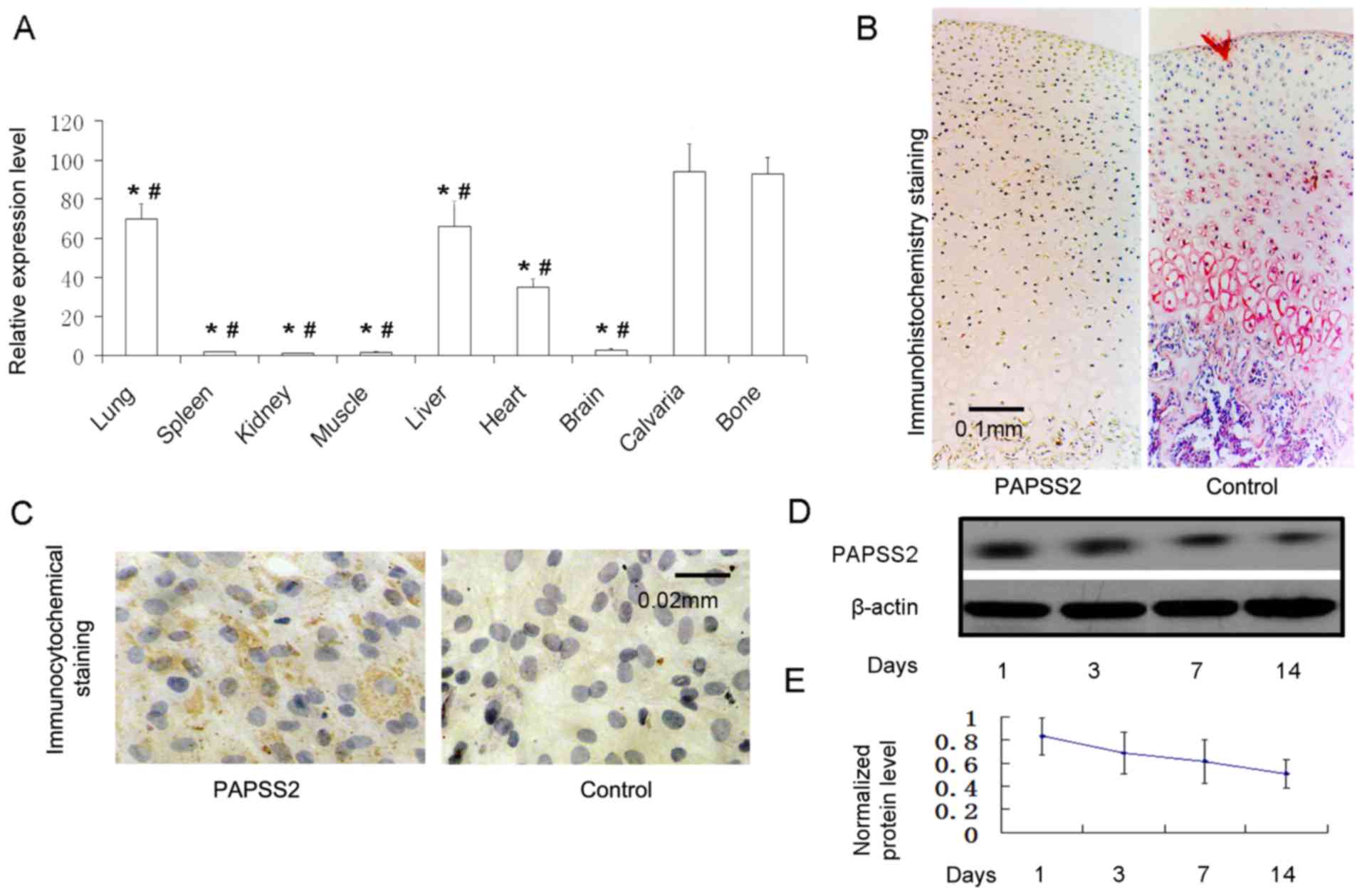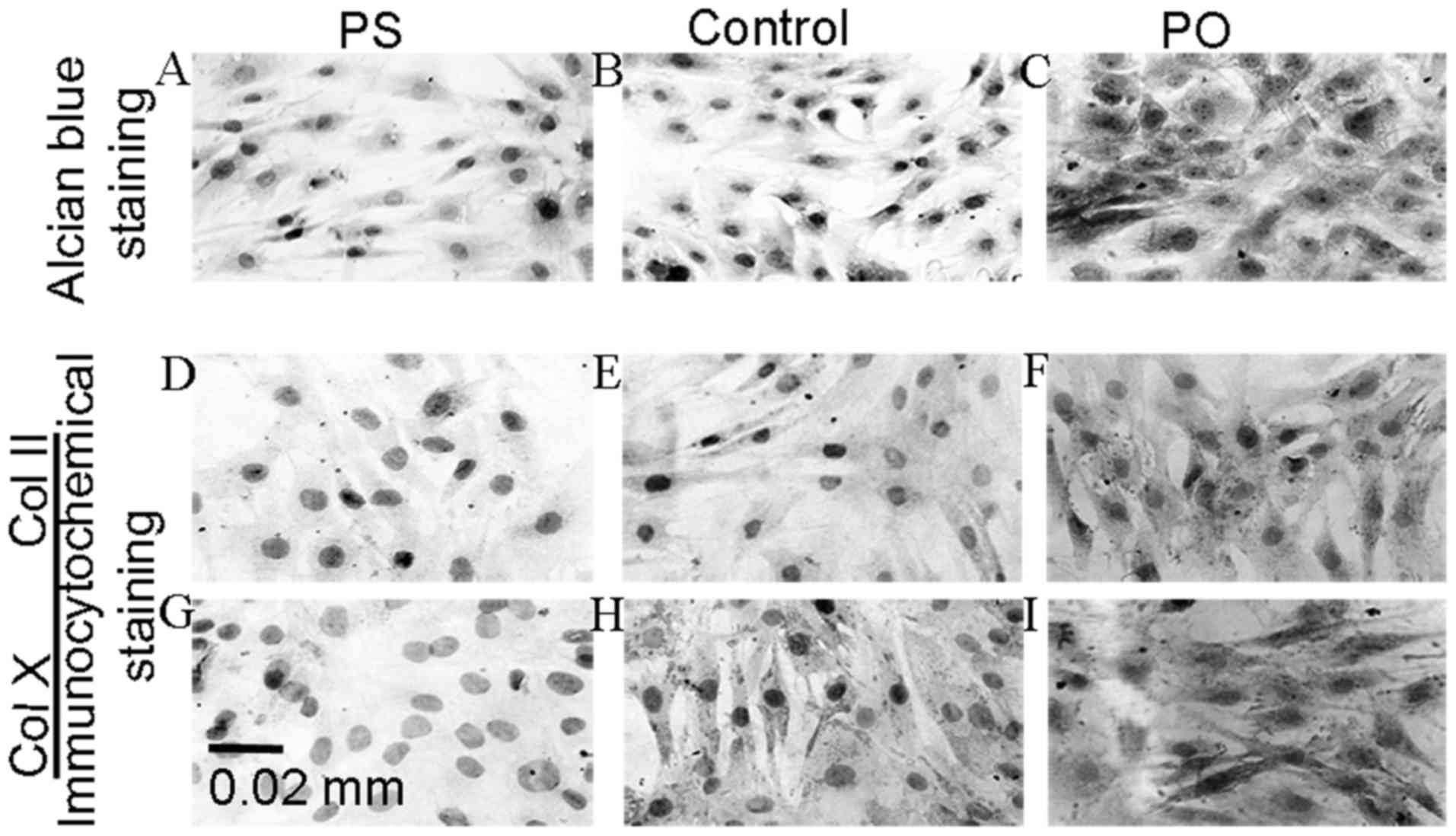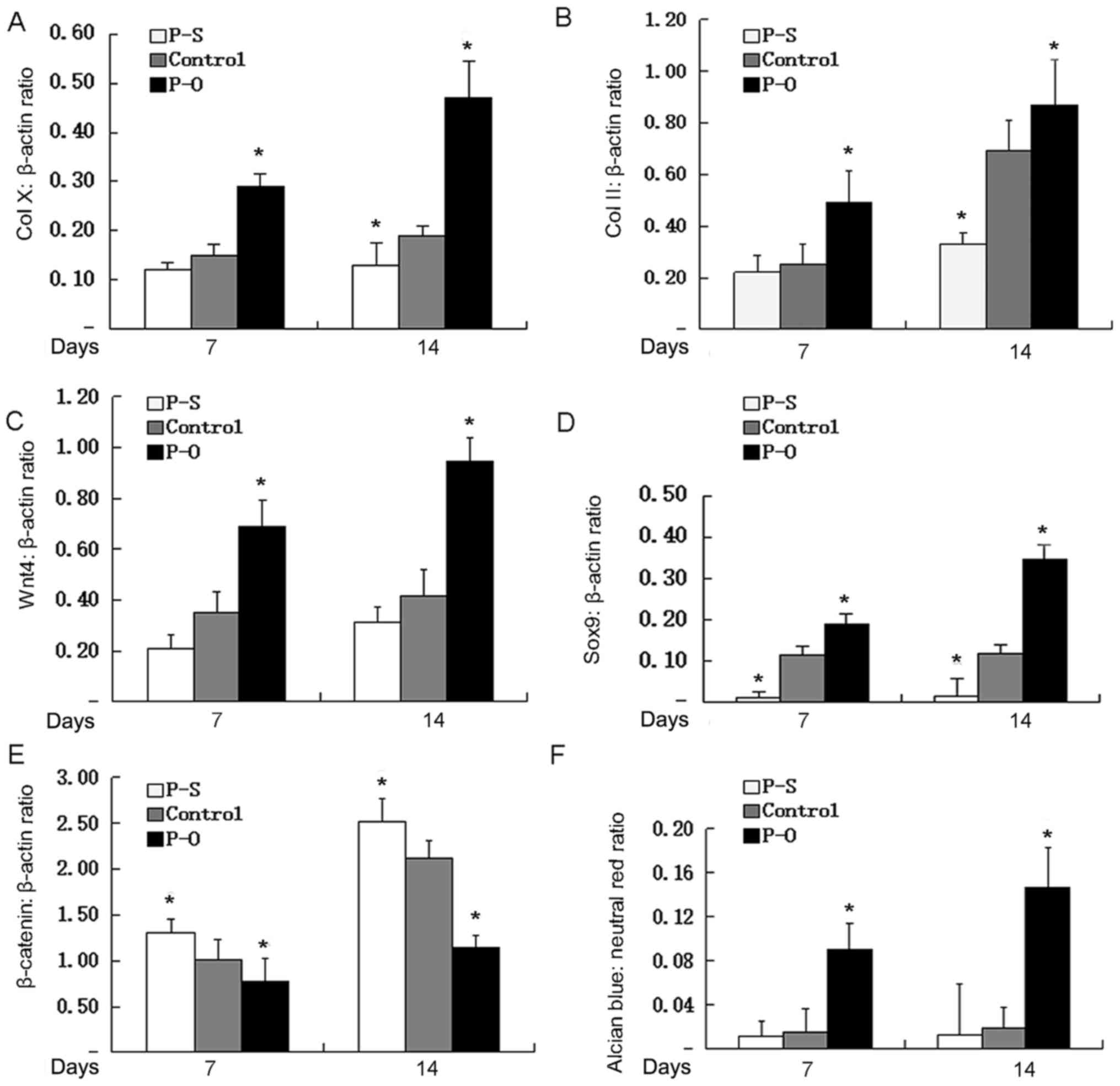|
1
|
Stupina TA and Shchudlo MM: A method for
making preparations from nondecalcified articular cartilage with
sublying subchondral bone for multipurpose studies. Bull Exp Biol
Med. 157:401–403. 2014. View Article : Google Scholar : PubMed/NCBI
|
|
2
|
Mobasheri A, Kalamegam G, Musumeci G and
Batt ME: Chondrocyte and mesenchymal stem cell-based therapies for
cartilage repair in osteoarthritis and related orthopaedic
conditions. Maturitas. 78:188–198. 2014. View Article : Google Scholar : PubMed/NCBI
|
|
3
|
Acharya C, Yik JH, Kishore A, Van Dinh V,
Di Cesare PE and Haudenschild DR: Cartilage oligomeric matrix
protein and its binding partners in the cartilage extracellular
matrix: Interaction, regulation and role in chondrogenesis. Matrix
Biol. 37:102–111. 2014. View Article : Google Scholar : PubMed/NCBI
|
|
4
|
Zhang F, Guo X, Wang W, Wu S, Ma W and Yan
H: Expression profile analysis of mycotoxin-related genes in
cartilage with endemic osteochondropathy Kashin-Beck Disease. BMC
Musculoskelet Disord. 13:1302012. View Article : Google Scholar : PubMed/NCBI
|
|
5
|
Xu ZH, Freimuth RR, Eckloff B, Wieben E
and Weinshilboum RM: Human 3′-phosphoadenosine 5′-phosphosulfate
synthetase 2 (PAPSS2) pharmacogenetics: Gene resequencing, genetic
polymorphisms and functional characterization of variant allozymes.
Pharmacogenetics. 12:11–21. 2002. View Article : Google Scholar : PubMed/NCBI
|
|
6
|
Xu ZH, Thomae BA, Eckloff BW, Wieben ED
and Weinshilboum RM; Pharmacogenetics of human 3′-phosphoadenosine
5′-phosphosulfate synthetase 1 (PAPSS1), . gene resequencing,
sequence variation, and functional genomics. Biochem Pharmacol.
65:1787–1796. 2003. View Article : Google Scholar : PubMed/NCBI
|
|
7
|
Peitzmeier SM, Reisner SL, Harigopal P and
Potter J: Female-to-male patients have high prevalence of
unsatisfactory Paps compared to non-transgender females:
Implications for cervical cancer screening. J Gen Intern Med.
29:778–784. 2014. View Article : Google Scholar : PubMed/NCBI
|
|
8
|
Xu ZH, Otterness DM, Freimuth RR, Carlini
EJ, Wood TC, Mitchell S, Moon E, Kim UJ, Xu JP, Siciliano MJ and
Weinshilboum RM: Human 3′-phosphoadenosine 5′-phosphosulfate
synthetase 1 (PAPSS1) and PAPSS2: Gene cloning, characterization
and chromosomal localization. Biochem Biophys Res Commun.
268:437–444. 2000. View Article : Google Scholar : PubMed/NCBI
|
|
9
|
Ford-Hutchinson AF, Ali Z, Seerattan RA,
Cooper DM, Hallgrimsson B, Salo PT and Jirik FR: Degenerative knee
joint disease in mice lacking 3′-phosphoadenosine 5′-phosphosulfate
synthetase 2 (Papss2) activity: A putative model of human PAPSS2
deficiency-associated arthrosis. Osteoarthritis Cartilage.
13:418–425. 2005. View Article : Google Scholar : PubMed/NCBI
|
|
10
|
Ramaswamy G, Sohn P, Eberhardt A and Serra
R: Altered responsiveness to TGF-β results in reduced Papss2
expression and alterations in the biomechanical properties of mouse
articular cartilage. Arthritis Res Ther. 14:R492012. View Article : Google Scholar : PubMed/NCBI
|
|
11
|
Stelzer C, Brimmer A, Hermanns P, Zabel B
and Dietz UH: Expression profile of Papss2 (3′-phosphoadenosine
5′-phosphosulfate synthase 2) during cartilage formation and
skeletal development in the mouse embryo. Dev Dyn. 236:1313–1318.
2007. View Article : Google Scholar : PubMed/NCBI
|
|
12
|
Thiele H, Sakano M, Kitagawa H, Sugahara
K, Rajab A, Höhne W, Ritter H, Leschik G, Nürnberg P and Mundlos S:
Loss of chondroitin 6-O-sulfotransferase-1 function results in
severe human chondrodysplasia with progressive spinal involvement.
Proc Natl Acad Sci USA. 101:10155–10160. 2004. View Article : Google Scholar : PubMed/NCBI
|
|
13
|
Alnouti Y and Klaassen CD: Tissue
distribution and ontogeny of sulfotransferase enzymes in mice.
Toxicol Sci. 93:242–255. 2006. View Article : Google Scholar : PubMed/NCBI
|
|
14
|
Wang W, Li F, Wang K, Cheng B and Guo X:
PAPSS2 promotes alkaline phosphates activity and mineralization of
osteoblastic MC3T3-E1 cells by crosstalk and Smads signal pathways.
PLoS One. 7:e434752012. View Article : Google Scholar : PubMed/NCBI
|
|
15
|
Meng F, He A, Zhang Z, Zhang Z, Lin Z,
Yang Z, Long Y, Wu G, Kang Y and Liao W: Chondrogenic
differentiation of ATDC5 and hMSCs could be induced by a novel
scaffold-tricalcium phosphate-collagen-hyaluronan without any
exogenous growth factors in vitro. J Biomed Mater Res A.
102:2725–2735. 2014. View Article : Google Scholar : PubMed/NCBI
|
|
16
|
Yao Y and Wang Y: ATDC5: An excellent in
vitro model cell line for skeletal development. J Cell Biochem.
114:1223–1229. 2013. View Article : Google Scholar : PubMed/NCBI
|
|
17
|
Newton PT, Staines KA, Spevak L, Boskey
AL, Teixeira CC, Macrae VE, Canfield AE and Farquharson C:
Chondrogenic ATDC5 cells: An optimised model for rapid and
physiological matrix mineralisation. Int J Mol Med. 30:1187–1193.
2012. View Article : Google Scholar : PubMed/NCBI
|
|
18
|
Temu TM, Wu KY, Gruppuso PA and
Phornphutkul C: The mechanism of ascorbic acid-induced
differentiation of ATDC5 chondrogenic cells. Am J Physiol
Endocrinol Metab. 299:E325–E334. 2010. View Article : Google Scholar : PubMed/NCBI
|
|
19
|
Wang WZ, Guo X, Duan C, Ma WJ, Zhang YG,
Xu P, Gao ZQ, Wang ZF, Yan H, Zhang YF, et al: Comparative analysis
of gene expression profiles between the normal human cartilage and
the one with endemic osteoarthritis. Osteoarthritis Cartilage.
17:83–90. 2009. View Article : Google Scholar : PubMed/NCBI
|
|
20
|
Livak KJ and Schmittgen TD: Analysis of
relative gene expression data using real-time quantitative PCR and
the 2(-Delta Delta C(T)) method. Methods. 25:402–408. 2001.
View Article : Google Scholar : PubMed/NCBI
|
|
21
|
Young AD, Phipps DE and Astroff AB:
Large-scale double-staining of rat fetal skeletons using Alizarin
Red S and alcian blue. Teratology. 61:273–276. 2000. View Article : Google Scholar : PubMed/NCBI
|
|
22
|
Oostdijk W, Idkowiak J, Mueller JW, House
PJ, Taylor AE, O'Reilly MW, Hughes BA, de Vries MC, Kant SG, Santen
GW, et al: PAPSS2 deficiency causes androgen excess via impaired
DHEA sulfation-in vitro and in vivo studies in a family harboring
two novel PAPSS2 mutations. J Clin Endocrinol Metab. 100:E672–E680.
2015. View Article : Google Scholar : PubMed/NCBI
|
|
23
|
Ikeda T, Mabuchi A, Fukuda A, Hiraoka H,
Kawakami A, Yamamoto S, Machida H, Takatori Y, Kawaguchi H,
Nakamura K and Ikegawa S: Identification of sequence polymorphisms
in two sulfation-related genes, PAPSS2 and SLC26A2, and an
association analysis with knee osteoarthritis. J Hum Genet.
46:538–543. 2001. View Article : Google Scholar : PubMed/NCBI
|
|
24
|
Chang CH, Chen CC, Liao CH, Lin FH, Hsu YM
and Fang HW: Human acellular cartilage matrix powders as a
biological scaffold for cartilage tissue engineering with
synovium-derived mesenchymal stem cells. J Biomed Mater Res A.
102:2248–2257. 2014. View Article : Google Scholar : PubMed/NCBI
|
|
25
|
Van Assche D, Staes F, Van Caspel D,
Vanlauwe J, Bellemans J, Saris DB and Luyten FP: Autologous
chondrocyte implantation versus microfracture for knee cartilage
injury: A prospective randomized trial, with 2-year follow-up. Knee
Surg Sports Traumatol Arthrosc. 18:486–495. 2010. View Article : Google Scholar : PubMed/NCBI
|
|
26
|
Edwards PK, Ebert JR, Janes GC, Wood D,
Fallon M and Ackland T: Arthroscopic versus open matrix-induced
autologous chondrocyte implantation: Results and implications for
rehabilitation. J Sport Rehabil. 23:203–215. 2014. View Article : Google Scholar : PubMed/NCBI
|
|
27
|
Temu TM, Phornphutkul C and Gruppuso P:
Characterization of chondrocyte differentiation of ATDC5 cell line
induced by Ascorbic acid. FASEB J. 24:2010.
|
|
28
|
Takayama Y and Mizumachi K: Inhibitory
effect of lactoferrin on hypertrophic differentiation of ATDC5
mouse chondroprogenitor cells. Biometals. 23:477–484. 2010.
View Article : Google Scholar : PubMed/NCBI
|
|
29
|
Kwon HJ, Yasuda K, Ohmiya Y, Honma K, Chen
YM and Gong JP: In vitro differentiation of chondrogenic ATDC5
cells is enhanced by culturing on synthetic hydrogels with various
charge densities. Acta Biomater. 6:494–501. 2010. View Article : Google Scholar : PubMed/NCBI
|
|
30
|
Itoh R, Miura S, Takimoto A, Kondo S, Sano
H and Hiraki Y: Stimulatory actions of lysophosphatidic acid on
mouse ATDC5 chondroprogenitor cells. J Bone Miner Metab.
28:659–671. 2010. View Article : Google Scholar : PubMed/NCBI
|
|
31
|
Challa TD, Rais Y and Ornan EM: Effect of
adiponectin on ATDC5 proliferation, differentiation and signaling
pathways. Mol Cell Endocrinol. 323:282–291. 2010. View Article : Google Scholar : PubMed/NCBI
|
|
32
|
Nakatani S, Mano H, Im R, Shimizu J and
Wada M: Glucosamine regulates differentiation of a chondrogenic
cell line, ATDC5. Biol Pharm Bull. 30:433–438. 2007. View Article : Google Scholar : PubMed/NCBI
|
|
33
|
Cortes M, Singh B, Kurima K and Schwartz
N: PAPS synthetase gene expression relates directly to the murine
Brachymorphism (Bm) phenotype. FASEB J. 17:A1303. 2003.
|
|
34
|
Al Attia HM: HLA tissue typing in patients
with PAPS (Hughes syndrome) evolving into SLE. Lupus. 11:399–400.
2002. View Article : Google Scholar : PubMed/NCBI
|
|
35
|
Shimizu C, Lee YC, Fuda H and Strott CA:
Promoter analysis of human PAPS synthase (PAPSS) 1 and 2. FASEB J.
15:A882. 2001.
|
|
36
|
Gomez JA, Martin H, Amigo MC, Aguirre MA,
Cuadrado MJ, Khamashta MA and Hughes GRV: Long-term follow-up in 90
patients with primary antophospholipid syndrome (PAPS). Do they
develop lupus? Arthritis Rheum-Us. 44:S1462001.
|
|
37
|
Venkatachalam KV: Human
3′-phosphoadenosine 5′-phosphosulfate (PAPS) synthase:
biochemistry, molecular biology and genetic deficiency. IUBMB Life.
55:1–11. 2003. View Article : Google Scholar : PubMed/NCBI
|
|
38
|
Weber M, deBandt M, Hayem G, Roux S, Kahn
MF and Meyer O: Familial study of primary (PAPS) and secondary
(SAPS) syndrome. Arthritis Rheum-Us. 40:16241997.
|
|
39
|
Krakow D, Sebald ET, Pogue R, Rimoin LP,
King L and Cohn DH: Analysis of clones from a human cartilage cDNA
library provides insight into chondrocyte gene expression and
identifies novel candidate genes for the osteochondrodysplasias.
Mol Genet Metab. 79:34–42. 2003. View Article : Google Scholar : PubMed/NCBI
|
|
40
|
Krakow D, Sebald ET, King LM and Cohn DH:
Cartilage expressed sequence tags provide insight into chondrocyte
gene expression and identify novel candidate genes for the
osteochondrodysplasias. Am J Hum Genet. 67:370. 2000.
|
|
41
|
Zhu Z, Yu A, Hou M, Xie X and Li P:
Effects of Sox9 gene therapy on the healing of bone-tendon
junction: An experimental study. Indian J Orthop. 48:88–95. 2014.
View Article : Google Scholar : PubMed/NCBI
|
|
42
|
Raspopovic J, Marcon L, Russo L and Sharpe
J: Modeling digits. Digit patterning is controlled by a
Bmp-Sox9-Wnt turing network modulated by morphogen gradients.
Science. 345:566–570. 2014.
|
|
43
|
Raspaglio G, Petrillo M, Martinelli E,
Puma DDL, Mariani M, De Donato M, Filippetti F, Mozzetti S, Prislei
S, Zannoni GF, et al: Sox9 and Hif-2α regulate TUBB3 gene
expression and affect ovarian cancer aggressiveness. Gene.
542:173–181. 2014. View Article : Google Scholar : PubMed/NCBI
|
|
44
|
Zhang H, Zhao X, Zhang Z, Chen W and Zhang
X: An immunohistochemistry study of Sox9, Runx2, and Osterix
expression in the mandibular cartilages of newborn mouse. Biomed
Res Int. 2013:2653802013.PubMed/NCBI
|
|
45
|
Yano F, Kugimiya F, Ohba S, Ikeda T,
Chikuda H, Ogasawara T, Ogata N, Takato T, Nakamura K, Kawaguchi H
and Chung UI: The canonical Wnt signaling pathway promotes
chondrocyte differentiation in a Sox9-dependent manner. Biochem
Biophys Res Commun. 333:1300–1308. 2005. View Article : Google Scholar : PubMed/NCBI
|
|
46
|
Yates KE, Shortkroff S and Reish RG: Wnt
influence on chondrocyte differentiation and cartilage function.
DNA Cell Biol. 24:446–457. 2005. View Article : Google Scholar : PubMed/NCBI
|
|
47
|
Gao Y, Liu S, Huang J, Guo W, Chen J,
Zhang L, Zhao B, Peng J, Wang A, Wang Y, et al: The ECM-cell
interaction of cartilage extracellular matrix on chondrocytes.
Biomed Res Int. 2014:6484592014. View Article : Google Scholar : PubMed/NCBI
|
|
48
|
Dao DY, Jonason JH, Zhang YC, Hsu W, Chen
D, Hilton MJ and O'Keefe RJ: Cartilage-specific β-catenin signaling
regulates chondrocyte maturation, generation of ossification
centers, and perichondrial bone formation during skeletal
development. J Bone Miner Res. 27:1680–1694. 2012. View Article : Google Scholar : PubMed/NCBI
|















